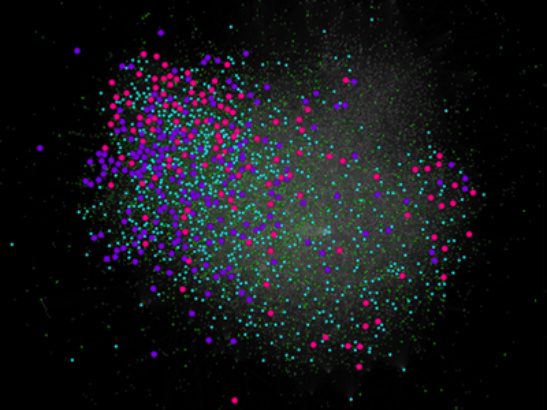.jpg)
‘Genomics’ has become a buzzword in recent years, especially as it is increasingly used in the clinic. Proteomics, on the other hand, remains a bit of a mystery to many people.
Simply put, genomics is the study of the entire set of genes in a person, whereas proteomics is the study of the entire set of proteins produced or modified by the body.
“Proteomics involves understanding how proteins function and interact with one another. Understanding how different proteins work together helps us understand diseases. Importantly, most of the current drugs that exist today are either proteins or they target specific proteins in the body,” explains Dr Paul Huang, who leads the Molecular and Systems Oncology Team at the ICR.
While we tend to see the genome as relatively constant or static – meaning that it is essentially always the same and only changes when a mutation occurs – the proteome is dynamic. It changes with time and is influenced by the body’s requirements or stresses.
For example, different tissues produce different sets of proteins and this varies from time to time, so it could be different in the morning compared to at night. Proteomic tools can therefore give us a better understanding of an organism, especially when coupled with other so-called ‘omic’ technologies such as genomics.
The blind men and the elephant
As Dr Huang explains, you could think of the analogy of the seven blind men – or, in this case, scientists – and the elephant.
“Imagine seven blind men who have never come across an elephant before try to figure out what it looks like just by feeling different parts of the elephant's body.
“If you just touch one part of the elephant at a time, you will not know it’s an elephant – and the same thing could be said for omic technologies. If you just use genomics, you will not get a holistic view of what cancer is. But if you integrate different data, for example by using proteomics, you will obtain a much better, fuller picture.”
In contrast to the cancer genome, there is a significant gap in our knowledge of the cancer proteome.
Proteomics at the ICR
At the ICR, Professor Jyoti Choudhary is Head of Proteomics at the ICR and leads our proteomics facility – performing protein analysis for researchers across the whole of the ICR.
In addition, Professor Choudhary and her team focus on understanding how the organisation and dynamics of protein networks underpin cancer’s ability to progress and resist treatment.
Recently Professor Choudhary and her team collaborated with scientists at Imperial to help uncover how bacterial proteins work as a network to take control of our cells. The findings could also be applied to explore the role of bacteria in the gut in some cancer types, such as bowel cancer.
Targeting proteins using drugs
Dr Huang uses proteomics in his research with the aim of better understanding sarcomas, one of the rarest forms of cancer – and a cancer of unmet need.
Patients with cancers of unmet need urgently need new treatment options. As a charity, your support is vital in helping us open up fresh avenues for research and treatment for these patients.
Proteome information can help researchers identify proteins associated with cancer. Once researchers have this information, they can look at the protein’s structure and design drugs that interfere with the action of the protein.
“The majority of drugs target proteins and not genes – so it makes sense, from a drug development point of view, to evaluate the state of proteins in cancer,” says Dr Huang. “The closer you are to figuring out which proteins you need to target, the more likely you are to develop drugs that work and use them in the right way.”
In other words, proteomics holds great promise in helping us treat cancer because it provides valuable tools for the discovery of drug targets. In this way, proteomics can help us translate basic science discoveries into targeted, more personalised, treatments.
Using proteomics to understand rare cancers
Dr Huang focuses on studying sarcomas, which are cancers of the connective tissues – bone, fat, muscle. Perhaps because of sarcomas’ complexity and their heterogeneity – meaning that the disease presents itself differently in different patients, who can also respond in different ways to the same treatment – genomics alone does not give us all the answers and information we need.
“Sarcomas are tumours that constitute one per cent of all cancers – they have different genetics and biology and they are very difficult to treat. A one-size fits-all approach won’t work here.
“For this reason we are using proteomics to try and better understand the biology of sarcoma – hopefully to identify new drug targets or repurpose certain drugs already used in more common cancers,” explains Dr Huang.
“We have a couple of ongoing studies where we have undertaken large scale proteomic analyses. We’ve profiled more than 300 sarcoma cases, of more than 10 different types of sarcomas.”
Next, Dr Huang and his team will continue to dive deep into the biology of sarcomas to fully understand the protein machinery that drives these diseases as they aim to come up with new, better ways of treating it.
Find out more about our sarcoma research.
